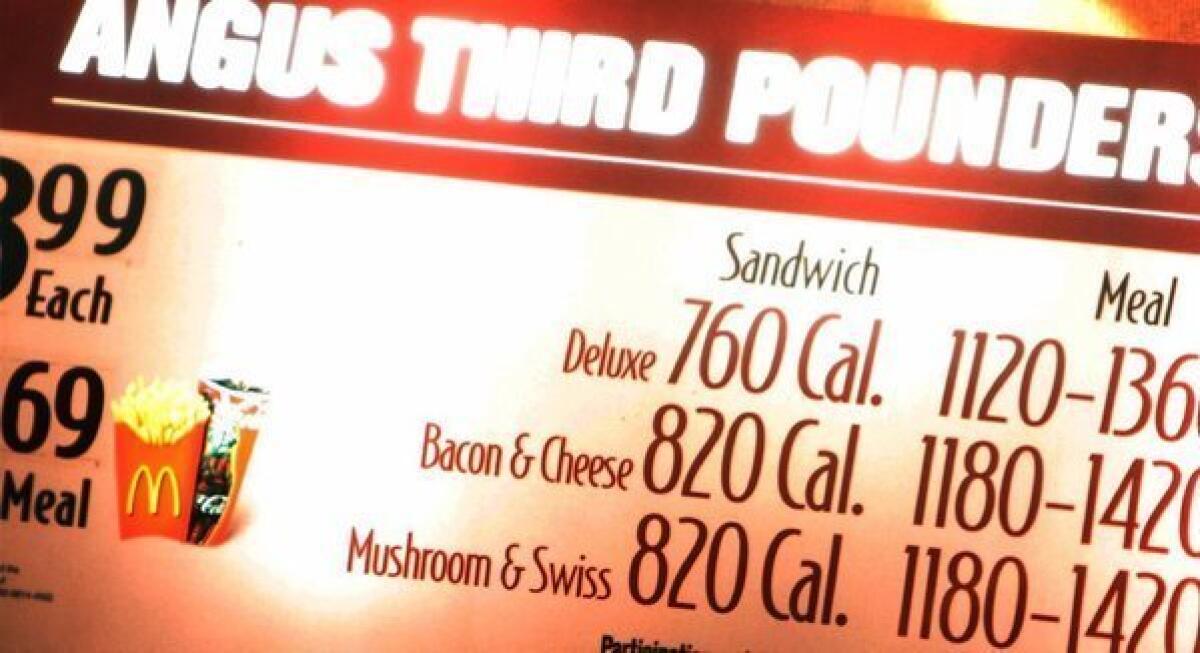Posting calories: ‘So yesterday’ already?

At chain restaurants across the country, the ink is scarcely dry on new menus posting the calorie counts of food and beverage options. But already, public health experts are debating whether there might be better ways to influence Americans’ nutritional choices when they’re out and about.
How about posting a menu item’s calorie content in “sweat equivalents” (it’ll take you 90 minutes of power-walking to work off the calories in this piece of cheesecake and 30 minutes to work off the fruit-and-yogurt combo)? How about listing food items on the menu in the order of their nutritional density or caloric content (apple slices before fries, nonfat milk before sugary soda)? How about requiring menus to make the lower-calorie food choices the “default” in a pre-set meal, and to picture that version of the meal on its menus?
Studies suggest that any of these variations are worth considering as alternatives to the straight-up calorie-posting requirements.
That chatter spilled over to the pages of the New England Journal of Medicine on Wednesday, where a pair of public health professors from Johns Hopkins University’s School of Public Health set their sights on the next big actors in the bid to reform Americans’ consumption habits--state and local governments.
As state and local governments begin to pick up the obesity fight where the federal Affordable Care Act leaves off, they should consider that “innovative calorie labeling on menus has the potential to be more effective than the status quo,” wrote Sara N. Bleich and Lainie Rutkow of Bloomberg School of Public Health.
The fact is, the early returns are showing that putting the calorie content of restaurant food on menus and posting them on menu boards is a bit of a bust. The calorie count of food items is often expressed in wide ranges that take account of different size options and condiment use (but allow consumers to lie to themselves), the federal requirements exempt more than half of U.S. restaurants, and a growing number of studies finds that posting calories hasn’t exactly revolutionized the nutritional choices we make when eating away from home.
Bleich and Rutkow note that calorie-posting appears least likely to influence the consumption patterns of those Americans most likely to be obese and to suffer the resulting health consequences--those with lower incomes and less education. It assumes a higher level of nutritional knowledge than many Americans have (how many calories should I eat in a day to maintain my current weight?), and greater analytical skill than most are willing or able to exercise (so, what proportion of my ideal daily calorie intake do those fries and cheeseburger represent, and how does that calculation change if I choose a salad instead?).
State and local governments have long been seen as the crucible of American democracy--the places where well-meaning programs crafted by federal officials get refined, translated and adapted to unique local needs. Federal officials are still drafting regulations to carry out the anti-obesity initiatives in the Affordable Care Act. But that law leaves to states and local governments plenty of flexibility to tailor those programs to the needs of their own populations.
“State and local governments now have a substantial opportunity to craft innovative menu labeling regulations that build upon the current evidence base,” wrote Bleich and Rutkow. They should launch pilot projects, and use that flexibility, to try new ways to coax Americans to choose well when eating out, they added.






